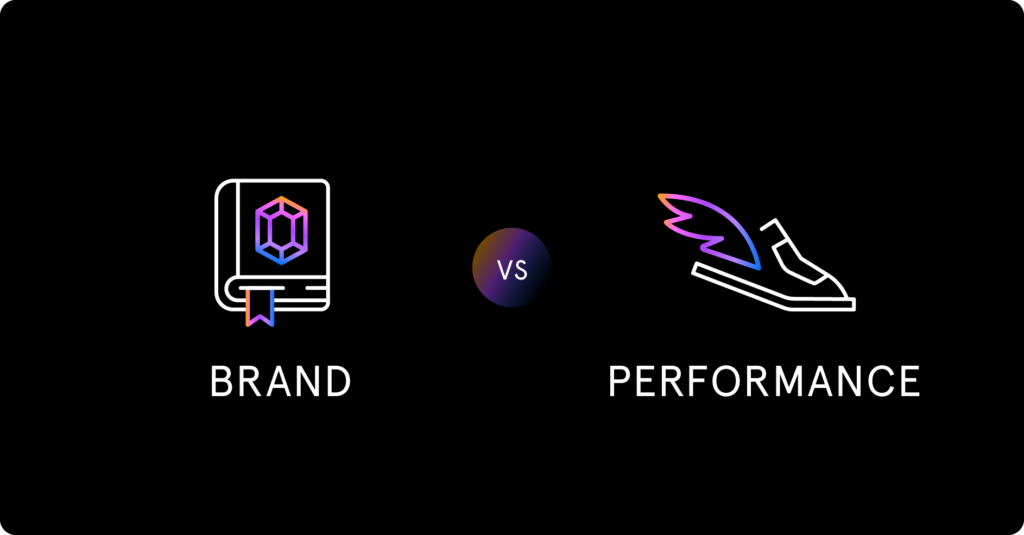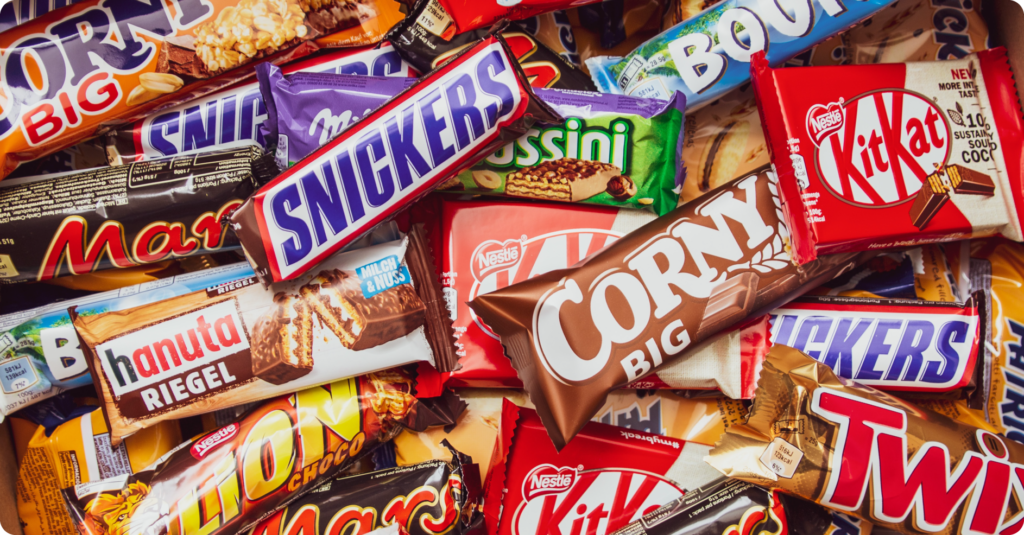For many of the most successful companies, their brand is their single most valuable asset. More so than physical infrastructure, proprietary innovations, or even their subscribers – the story of who they are matters more than literally anything else. In the 21st century, creating any level of brand affinity doesn’t happen without an investment in brand-based marketing. If your brand has a unique story, compelling values, or a mission to make the world a better place, marketing that mission becomes even more powerful for you.
Thought experiment – you can only have 1 of these customer experiences, so which would you choose?
- A customer buys a product at full price, but immediately forgets who you are…
- A customer gets a product for free, but fully understands your brand, your story, and what you represent…
This isn’t a trick question – there is no right or wrong answer here. The dynamic between option 1 and 2 is a simplified take on the brand vs. performance marketing question that marketing leaders consider. It’s the idea of whether you should invest in individual transactions or invest in telling your story.
Increasingly, marketers are pivoting to brand- and mission-based marketing strategies. One of the highest-profile examples of this switch is Airbnb. In the face of tough macroeconomic conditions, their 2022 Q3 was their strongest quarter EVER, with revenue surging by 29%.
Here’s what the CFO said about how their brand marketing strategy contributed to this historic quarter:
“Our brand marketing results are delivering excellent results overall with a strong rate of return, and it’s been so successful that we’re actually expanding to more countries. And so, that’s what you’ll be seeing over the course of [the] next years to expand more countries to support our brand advertising.”
At the core of their brand- and values-focused marketing push was the Airbnb mission statement: “Our mission is to unlock the power of sharing space, resources, and support in times of need.”
There’s no question it worked for them – and that the timing is perfect…
Companies that don’t have a strong brand will languish when trying to market in a recession. You’ll find yourself spending more and more money to acquire customers who are conversely looking to spend less than ever. However, established brands who have a loyal customer base are the best equipped to survive an economic downturn.
Investing in telling your company’s story could be the silver bullet for weathering a possible recession. Let’s dig into brand-focused marketing, define some key terms, and explore the best practices!
Brand vs. performance marketing at a glance

To get started on the brand vs. performance marketing analysis, let’s make sure we have a solid definition of the strategies at the core of this conversation:
Brand Marketing – Brand marketing is a focused effort to create awareness of – and affinity for – your brand. Done by leveraging your brand story and values, the goal of brand-based marketing is to create a loyal consumer base. The goal of brand building as a marketing strategy is to create an emotional relationship with your customer base. If you achieve this, your product is no longer just a commodity – your brand becomes a part of their life that they cherish.
Performance Marketing – Performance marketing is a strategy that focuses on specific, measurable results. The success of performance marketing is primarily measured by goals like transactions made, demos booked, trials started, downloads requested, or webpage visits.
On the surface, you might think that these 2 big-picture strategies are complete opposites, but the truth is that there is significant overlap. Backed by a compelling message and relevant value proposition, your awareness play for a brand campaign can absolutely drive immediate ROI. On top of that, you should certainly use some performance metrics to understand the impact of the brand campaign.
On the other hand, even the most conversion-heavy performance campaign can pull double duty by building your brand. The ad copy, your landing pages, product description, and sales posts all showcase at least an iota of your company values – even if that’s not their primary job. However, when your marketing is optimized for maximum performance above all else, showing up as one brand becomes much harder. If performance metrics are the bottom line, it’s not uncommon to see brands sacrifice their story for that extra element of conversion rate optimization.
Really, the question is whether you want a heavier push on brand or performance marketing – not either/or. Think about the brand marketing push that Airbnb credited with their explosive Q3. They didn’t fully cancel PPC campaigns for keywords like “vacation rentals” – they just placed their main focus elsewhere.
Here’s a breakdown of the pros and cons of each approach to marketing:
Pros of Brand-Focused Marketing
✅ Create lifelong, loyal customers – If who you are as a brand and what you do resonates with consumers, they will continue to buy from you. They buy from you because they are no longer making just a logical decision with their purchase – your customers will be making an emotional decision. Even if there are cheaper or more convenient options, the right brand story keeps them committed to you. This is an invaluable asset.
✅ Impossible to mimic – The brand story you tell is unique to your company, especially if there is a mission behind it. If you’re struggling with differentiating yourself in a crowded field, tell your story – don’t just fight for the top paid spots.
✅ A long-lasting investment – The investment you make into the creative copy and placements that tell your brand story can drive decades of purchases and loyalty. Brand-based marketing can demonstrate some of the highest long term ROI in the game. This advantage makes brand an essential part of many recession strategies.
Cons of Brand-Focused Marketing
❌ Won’t see results right away – Effective brand marketing is just that. It tells your story. So while you might inspire and connect on an emotional level, you won’t necessarily capture demand. However, because you’ve captured the heart and mind of the customer, they will choose you again and again when the time is right. Therefore, while in the short term showing ROI can be challenging, remember brand marketing is a long game.
❌ Brand marketing is recognized as generally harder – All marketing initiatives (especially ones executed at-scale) are challenging. Experts who have experience with performance and brand generally say that brand-based marketing is more challenging. Simply put: your messaging needs to be perfect and your execution needs to be flawless. Airbnb established themselves as the vacation rental service for sharing space in times of need. Imagine if they chose the wrong message – rather than reveling in a historic quarter, they’d have to be doing damage control.
The Opal platform was built to make marketing easier…
Pros of Performance Marketing
✅ Immediate, trackable gains – The ROI you enjoy from your performance marketing campaigns gets added to the bottom line much sooner. On top of that, since you’re advertising to achieve specific metrics, you’ll be able to track how effectively the marketing is performing right away.
✅ Easy to pivot & optimize – Since you’ll have a clear idea of what’s working immediately, performance marketing can be optimized much sooner. As soon as you have a sufficient sample size, you can begin tweaking your images, copy, offers, ad placement, and more.
✅ Can work in a vacuum – In order to make brand- or mission-driven marketing, you need a solid story, a compelling mission, or a brand promise. That is a prerequisite for this marketing style. On the other hand, performance marketing works in a vacuum – all you need is the budget!
Cons of Performance Marketing
❌ More likely to create one-time customers – Since this discipline targets immediate sales-related outcomes, the possibility of creating one-time customers is very likely. This makes performance-based strategies much more of a short term investment.
❌ You just get what you pay for – With a performance-exclusive strategy, you buy impressions, clicks, and – hopefully – transactions. But that’s where your leverage ends. You get exactly what you pay for.
❌ Must maintain the investment – In order to maintain a set level of performance, your marketing budget will always need to meet or exceed your previous levels. While Airbnb likely will never reduce their budget, they likely could without losing much market share. That is never an option for performance-only strategies.
Looking Into Mission-Based Marketing
Now that we have a good grasp on brand vs. performance marketing, let’s explore a niche – yet powerful – style of brand-based marketing.
Mission-based marketing (also called values-based marketing) highlights the good your brand does in the world. Mission- or values-based marketing puts the good as the centerpiece of all branding efforts to earn customer affinity, attention, and loyalty. Whether that’s your environmental stewardship, community impact, or charitable contributions – brands committed to making the world a better place can leverage that with consumers. A prime example of this comes from a recent survey that showed that 58% of consumers (across Baby Boomers, Gen X, Millennials, and Gen Z) are willing to spend more on sustainable products.
In practice, this looks like putting the values you hold at the center of your brand. TOMS Shoes is a case-in-point as a values-based marketing example. The one detail about TOMS that almost everyone knows is that they donate a pair of shoes for every pair sold. Since the company launched in 2006, their “One For One” mission has been the centerpiece of their brand and their marketing. This brand mission catapulted TOMS to international recognition.
No discussion of mission-focused marketing would be complete without highlighting the B Corp movement. Earning B Corp certification (created by non-profit B Lab) means that the certified company has committed to using their business as a vehicle for positive change. Earning B Corp certification requires a whole-company commitment to the environment, their employees, and underserved communities. Simply put: B Corp certification signifies a genuinely ethical and charitable business. Naturally, TOMS Shoes is an official B Corp, having earned their certification in 2018.
Values-Based Marketing Example: Nespresso

One of our favorite values-based marketing examples comes from Opal customer, Nespresso.
Nespresso has always had a unique brand positioning. The luxury coffee line made a splash with brand-focused marketing that cemented Nespresso as the premiere way to indulge in exceptional espresso…anywhere, even at home. In fact, you may remember their commercials with Nespresso brand ambassador, George Clooney.
However, in April of 2022, Nespresso became a certified B Corp, prompting them to incorporate this distinction into their brand messaging. In fact, they launched values-based marketing campaigns, centered on the efforts that enabled them to earn B Corp certification.
Here are 3 prominent places you can see Nespresso’s values-based marketing examples right now:
- Streaming & broadcast commercials – Nespresso has an entire line of prominent commercials that advertise their status as a “freshly certified” B Corp – as well as their exceptional coffee flavors.
- YouTube series – On their official YouTube platform, Nespresso publishes video series that highlight their commitment to sustainability, the climate, and going carbon neutral.
- Homepage content – The Nespresso homepage exemplifies what B Corp marketing can look like. Their header features stories about Nespresso’s efforts to create sustainable practices and gender equality in coffee farming. These pieces of values-based branding sit among callouts for new products and classic lifestyle features.
Of course, Nespresso didn’t suddenly abandon the messaging that served them for decades. Their brand didn’t abruptly change into something unrecognizable – it grew.
Their new brand promise exemplifies this: “At Nespresso, we promise consumers the finest coffee in the world that preserves the best of our world.”
Planning Your Brand in Opal
At Opal, we place a focus on brand marketing because we are privileged to see it executed by some of the globe’s best-recognized companies. Brands such as Target, Microsoft, Nespresso, and many more choose to manage their marketing in Opal.
Opal is a dedicated content operations platform that enables marketers to plan, create, and calendar their work. This gives you and your team a single platform to guide your marketing from initial ideas and briefs, through previews and approvals, all the way to scheduling on a calendar.
If you’re considering a push with an expanded brand marketing or performance marketing campaign, this might be the perfect time to upgrade your tech stack. If you’re interested in seeing how Opal empowers marketers, request a personalized demo from our product experts.

